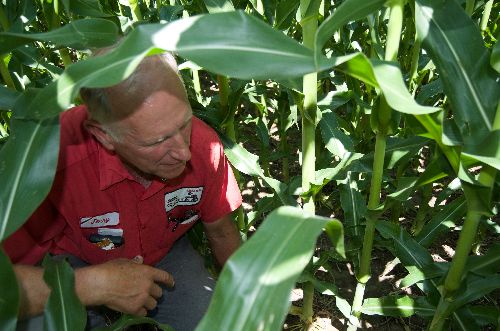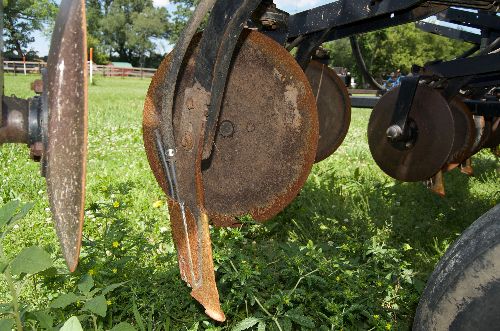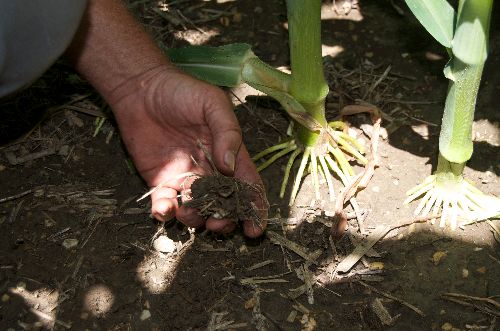With his bare-bones row-unit setup on a rented toolbar, Jerry Henkel doesn’t consider himself a traditional strip-tiller. But for the last 15 years, Henkel’s simple approach to strip-till has helped reduce nitrogen usage, improve corn yields and nearly eliminate erosion concerns.
A no-tiller since 1991, Henkel moved to strip-tilled corn so he could target application of fertilizer — especially nitrogen — beneath the soil surface, while avoiding invasive tillage. Henkel relies on a custom-built strip-till unit to place anhydrous ammonia in shallow fall strips on his 1,700-acre corn and soybean operation near Amboy, Ill.
“Our primary goal on the farm has always been good stewardship of the land and looking at net return, rather than just bushels we harvest,” Henkel says. “If we have to sacrifice a couple of bushels, but come out ahead on the bottom line, it’s a no-brainer.”
Henkel has overcome some early challenges adopting strip-till, increasing corn yields by several bushels each year and currently averaging close to 200 bushels per acre.
“It’s been a steady rise and even in 2012, when it was so dry, my brother was running our combine and called me to ask if our Dad would ever have imagined we could produce more than 300 bushels of corn on that particular farm,” Henkel says. “I know it would have brought a smile to his face knowing that we could harvest record yields in a drought year.”
Nutrient Lessons
Henkel’s first foray into strip-tilled corn was with a rented 12-row DMI toolbar with a shank setup on the row units. He built fall strips, deep-placing anhydrous along with potash and diammonium phosphate (DAP) 7 inches below the soil surface.
|
|
“We weren’t necessarily having problems with no-till, but we just felt there would be a benefit from planting into a real mellow strip of soil,” Henkel says. “We started out with strip-till the way we’d seen others doing it and basically turned every farm into a test plot.”
Henkel applied fertilizer in the strip in every other row to see if there would be a difference in yield. At the end of the first year, he saw some surprising results.
“On every field in rows where we deep-banded fertilizer, we took a yield loss of about 5 or 6 bushels per acre,” he says. “After 10 years of no-till, our soils were in good shape, so it got us thinking about whether we were concentrating too much fertilizer in the strip.”
Henkel tried deep-banding fertilizer a second year on a smaller number of strip-tilled acres, but ended up with the same yield loss. He then decided to abandon application of phosphorus and potassium with the strip-till rig and solely apply fall anhydrous, typically about 4 to 5 inches below the soil surface.
Today, he broadcast applies potash and DAP in the fall, based on soil-test results, and also variable-rate spot applies ag lime in some fields to level out fertility levels.
Reducing fertilizer use wasn’t a primary strip-till objective for Henkel. But during the last 10 years, he’s been able to scale back nitrogen application and still maintaining consistent corn yields.
“We’ve taken total use of nitrogen from recommended rates of 250 units down to about 160 or 170 units to achieve our yield goals, depending on the farm,” Henkel says. “Long-term no-till has certainly helped improve our soil health, but we learned with strip-till that we were apparently applying more nitrogen than the crop could use.”
Henkel typically applies about 100 units of anhydrous with the strip-till rig in the fall and sidedresses the balance in spring. He doesn’t apply any fertilizer with their 16-row Case IH planter.
“We’ve talked about going that route, but we’re not doing a lot of corn-on-corn, so we feel that we’re getting some nitrogen credits on our soybean ground going to corn,” Henkel says. “We’ve been able to cut back on total nitrogen use and are still experimenting.”
Erosion Control
Another change Henkel made, based on his early strip-till experience, was switching out the conventional shanks when he moved to a rented 16-row DMI toolbar. He felt the shanks were too aggressive.
|
|
“Most of our ground is highly erodible land (HEL) and we found those first couple of years with strip-till actually increased erosion,” he says. “If we’d get a flash rain in the spring, especially on our rolling ground, I was always concerned about the soil washing down the hills and it was a gut-wrenching site to see that in the field.”
Henkel found that looser soil on top of a 2- or 3-inch berm tended to washout with heavy rain. He experimented with different knives, and even tried to reshape conventional mole knives, but with their design, they still disturbed too much soil. He settled on using modified mini-mole knives, which are narrower and shorter than conventional knives.
“The first spring after using them the previous fall, we walked into the field and could hardly tell where the strips were,” Henkel says. “If the field has what I consider to be adequate moisture, I may only go a couple inches deep, to where I can seal the nitrogen.
“I’m not out there to do tillage, and since we’ve been using the modified mole knives for the last 10 years we’ve pretty much eliminated the erosion problems we’d had in the strips.”
Henkel uses Trimble’s RTX guidance to stay on the strips and the only other tools on the DMI row units are two coulters in front and closing discs in the back. Henkel says he hasn’t needed residue managers on the strip-till rig because residue breaks down rapidly.
“We’ve got earthworm factories in our fields,” Henkel says. “I’ll walk into our fields in the middle of July and they are basically stripped of residue. There might be a corn cob, but that’s about it.”
Cover Crop Experiments
While Henkel has solved many of his early problems, he’s still looking for the right solution for incorporating cover crops into his strip-till operation. Henkel’s goal is to increase microbial activity and soil health on some of his lower producing strip-tilled corn fields.
|
|
But he’s had little success, especially with annual ryegrass.
“We tried annual ryegrass because we’d heard about the immense root system they develop, but we’ve not seen it on our farm and we’re not quite sure why,” Henkel says. “The last 2 years, we’ve had 100% winter kill.”
This past year, Henkel planted annual ryegrass and radishes into his seed corn fields in mid-August. After receiving ¾ inches of rain, the cover appeared to have germinated well, but the crop didn’t survive the winter.
“The worst thing about it is where we planted annual ryegrass 2 years ago in those fields, we’re running into problems where the ryegrass didn’t germinate and it comes up as a weed the next year,” Henkel says. “Now we’re having to spray those fields and that’s scary.”
This year, Henkel says he plans to experiment with a different cover-crop mix on his strip-tilled fields, perhaps using a combination of cereal rye and oats.
“We’re not giving up and if we can conquer cover crops, we can continue to lower the amount of nitrogen we use,” he says. “Then we’ll be able to capture and better hold those nutrients in the soil.”









